As you ponder bringing backyard chickens into your life, you're likely envisioning a picturesque scene of happy hens pecking away in your yard. But before you start building that coop, having a firm grasp on the logistics is crucial. You'll need to navigate local regulations, design a safe and healthy environment, and plan for daily care and feeding. And that's just the beginning. From predator protection to waste management, there are many details to ponder. By understanding what's involved, you'll set yourself up for a successful and enjoyable experience – but are you prepared to take on the responsibilities that come with backyard chickens?
Zoning Laws and Ordinances
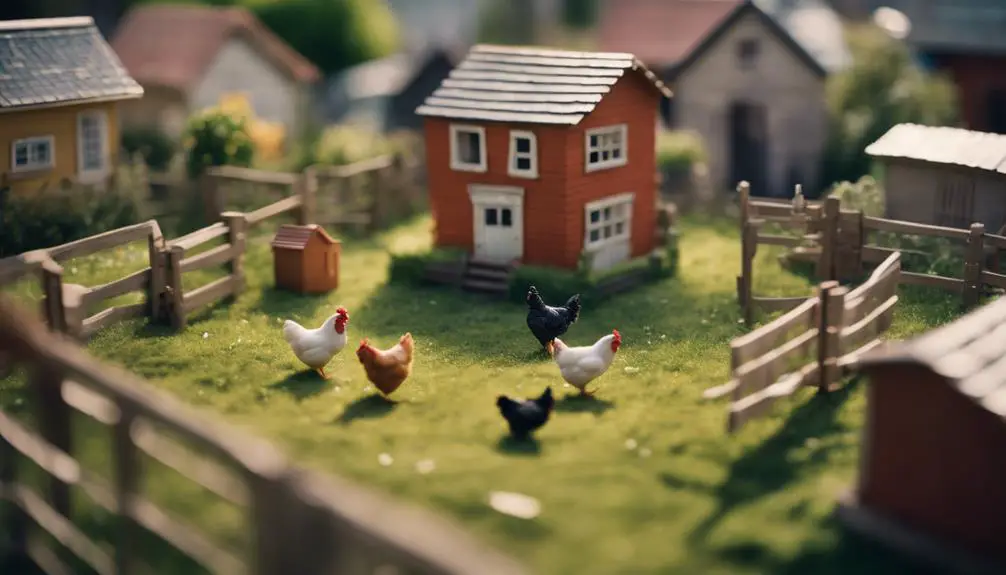
Before bringing backyard chickens home, you need to determine whether local zoning laws and ordinances allow for backyard chicken keeping in your area.
Vital to research and understand the regulations that govern your neighborhood, as they can vary markedly. Some cities have specific rules regarding the number of chickens you can keep, noise restrictions, and even requirements for coop size and design.
You may need to obtain zoning exemptions or special permits to keep backyard chickens.
Urban farming, including backyard chicken keeping, is becoming increasingly popular, and many cities are adapting their laws to accommodate this trend.
However, it's still paramount to check with your local government to verify you're not violating any ordinances.
Failing to comply can result in fines, penalties, or even the removal of your chickens.
Don't assume that just because your neighbor has chickens, you can too.
Take the time to research and understand the laws in your area, and you'll be well on your way to enjoying the benefits of backyard chicken keeping.
Coop Size and Space Requirements
When it comes to coop size and space requirements, you'll need to ponder the square footage of your coop and the amount of space each chicken will need.
A good rule of thumb is to provide at least 3-4 square feet of space per chicken inside the coop, and 8-10 square feet of outdoor run space per bird.
Coop Square Footage
You'll need to provide your backyard chickens with a coop that offers sufficient square footage to guarantee their health, happiness, and productivity. The coop's size is vital, as it directly impacts the welfare of your flock.
When it comes to coop square footage, consider the overall aesthetic you want to achieve. Do you envision a modern, sleek design or a rustic, charming coop that blends with your backyard? Coop customization is key to creating a unique space that meets your needs and complements your outdoor area.
A general rule of thumb is to provide at least 3-4 square feet of interior space per chicken inside the coop. However, this can vary depending on the breed and size of your chickens.
It's vital to research the specific needs of your flock to guarantee you're providing adequate space. Keep in mind that a larger coop doesn't always mean better. You'll need to balance space with ventilation, insulation, and ease of cleaning.
Per Chicken Space
To determine the ideal coop size, you need to calculate the per chicken space requirements, which involve evaluating factors beyond the general rule of thumb of 3-4 square feet per bird.
Chicken comfort and space efficiency are vital, so don't just focus on the minimum requirements. You'll want to ponder the breed, size, and activity level of your chickens, as well as the climate and management style.
For example, larger breeds or birds that are prone to feather pecking may require more space. Similarly, if you live in a hot climate, you'll want to guarantee your coop provides adequate ventilation and shade to prevent overheating.
You should also ponder the layout of the coop, including the placement of roosts, nesting boxes, and feeding areas, to guarantee a smooth flow of traffic and minimize stress.
Predator Protection Strategies
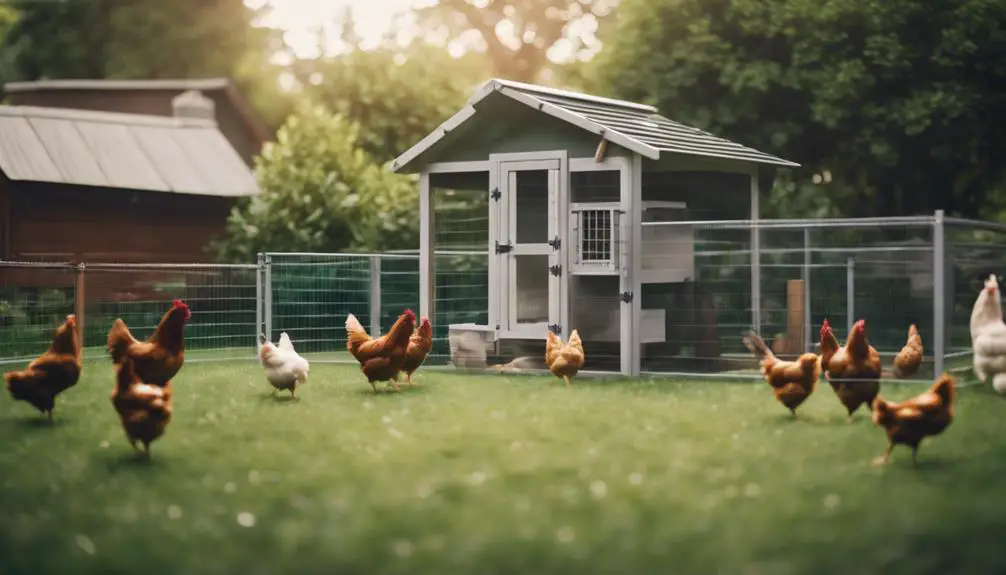
Protect your backyard chickens from predators by implementing a multi-layered defense strategy that includes a combination of physical barriers, clever chicken coop design, and vigilant monitoring.
One vital aspect of this strategy is predator profiling, which involves identifying the types of predators common to your area and understanding their behaviors and habits.
For instance, if you live in an area with coyotes, you'll want to focus on securing your coop and run with sturdy fencing and locking systems.
Electric fencing is an effective deterrent, as it delivers a painful shock to predators that try to breach the perimeter.
Additionally, consider using hardware cloth, a type of metal mesh, to cover windows and vents, as it's difficult for predators to chew through.
Chicken Health and Hygiene
Regularly monitoring your chickens' behavior and droppings is crucial for maintaining their health and hygiene.
By doing so, you'll be able to identify any potential issues before they escalate into serious problems. Keep an eye out for signs of stress, aggression, or fear, as these can indicate underlying health issues or flock dynamics problems.
Chicken behavior can be a great indicator of overall health, so take note of any changes in appetite, energy levels, or social interactions.
A clean and well-maintained coop is also essential for preventing the spread of disease.
Remove soiled bedding regularly, and disinfect all surfaces to prevent bacterial and fungal growth.
Guarantee your chickens have access to fresh water and a balanced diet to keep their immune systems strong.
Daily Care and Feeding Schedules

You'll want to establish a daily care and feeding schedule that certifies your chickens receive the attention and nutrition they need to thrive.
Start by developing a morning routine that includes letting your chickens out of their coop, revitalizing their water, and providing a nutritious breakfast. A balanced diet should include a high-quality layer feed, supplemented with fruits and vegetables. Avoid overfeeding, as this can lead to obesity and other health issues.
Establish a consistent feeding schedule to confirm your chickens know when to expect meals. Free-ranging chickens may require less feed, as they'll forage for insects and plants.
Monitor your chickens' feeding habits to identify any signs of illness or stress. Keep an eye out for changes in appetite, droppings, or water consumption, as these can indicate underlying health issues.
Egg Production and Expectations
As you start collecting eggs from your backyard flock, you'll naturally wonder what to expect from your chickens' daily production.
You'll soon learn that the number of eggs you'll get daily depends on several factors, including the breed and age of your chickens.
Understanding these factors will help you set realistic expectations and appreciate the unique characteristics of your backyard eggs.
Daily Egg Output
Your backyard chickens will produce an average of 280-300 eggs per year, depending on breed, nutrition, and environmental factors.
You can expect your hens to lay around 0.7-0.8 eggs per day, with some breeds producing more frequently than others.
Don't be surprised if you find more eggs in the nesting box during peak production periods, usually between 18-24 weeks of age.
Egg quality factors like shell thickness, yolk color, and albumen clarity will also vary depending on your chickens' diet and health.
You'll notice a range of egg colors, too, from creamy whites to deep browns and even blues, depending on the breed.
For instance, Leghorns tend to lay white eggs, while Marans produce dark, chocolate-brown ones.
As you collect your daily eggs, keep an eye out for any unusual colors or patterns – it's all part of the fun of backyard chicken-keeping!
Breed Affects Production
Different breeds of chickens have unique characteristics that influence their egg production, and understanding these traits is essential for setting realistic expectations for your backyard flock.
You'll want to research the breed history of your chickens to understand their egg-laying potential. For instance, Leghorns, known for their high egg production, can lay up to 300 eggs per year. On the other hand, Orpingtons, with their friendly and docile nature, may lay around 200 eggs per year.
When selecting breeds, consider flock dynamics and how the breeds will interact with each other. Some breeds are more dominant and may bully others, affecting egg production.
You'll want to create a harmonious flock that encourages healthy egg production. It's also vital to understand that egg production slows down as chickens age. Be prepared to adjust your expectations accordingly.
Egg Size Matters
When it comes to egg production, you'll soon discover that egg size matters, and understanding what to expect from your backyard flock will help you appreciate the varying sizes and frequencies of eggs they produce.
Different breeds produce eggs of varying sizes, from small bantam eggs to large, jumbo eggs. Some breeds, like Leghorns, are known for their high egg production, laying around 280-300 eggs per year, while others, like Orpingtons, may lay fewer but larger eggs.
Egg color is also an important factor to weigh. Some breeds, like Ameraucanas, lay blue or green eggs, while others, like Marans, produce dark, chocolate-brown eggs.
Yolk size is another aspect to ponder, as some breeds, like Barnevelders, are known for their rich, large yolks. Understanding these variations will help you manage your expectations and appreciate the unique characteristics of your backyard flock.
Breed Selection and Characteristics
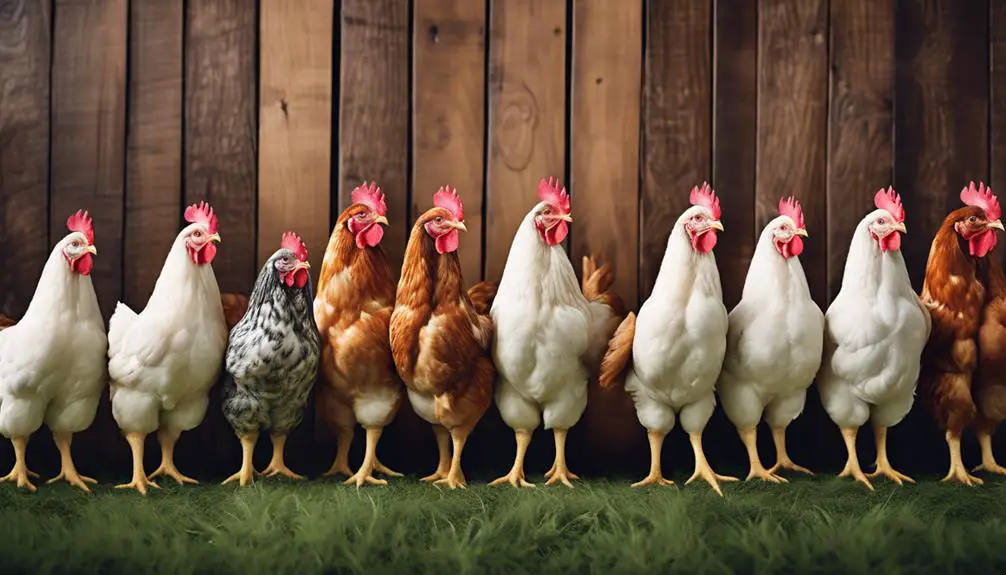
Selecting the right breed for your backyard flock is crucial, as it determines the egg-laying capacity, temperament, and overall success of your chicken-keeping venture.
You'll want to ponder the dynamics of your flock, including the number of birds, their size, and their personalities. Some breeds, like Leghorns, are prolific layers but can be skittish and flighty. Others, like Orpingtons, are friendly and docile but may not produce as many eggs.
You'll also want to think about the feather colors and patterns you prefer. Do you like the sleek, black feathers of a Silkie, or the soft, fluffy plumage of a Brahma?
When choosing a breed, ponder your climate, available space, and the amount of time you can devote to caring for your flock.
Some breeds, like Rhode Island Reds, are cold-hardy and require minimal upkeep, while others, like Polish crested chickens, need more attention and specialized care.
Fencing and Enclosure Options
Now that you've chosen the perfect breed for your backyard, it's time to think about how you'll keep them safe and secure.
You'll need to decide on a fencing material that suits your climate and budget, as well as a strategy to protect your chickens from predators.
In this section, we'll explore the various options for fencing and enclosures, including coop entrance designs that'll make your life easier.
Fence Material Options
Determine the type of fence material that will best protect your backyard chickens from predators and prevent them from flying the coop by considering factors like durability, cost, and aesthetics.
You'll want a fence that's sturdy enough to withstand curious critters and harsh weather conditions. Wire mesh is a popular choice, offering excellent protection against predators while allowing for airflow and visibility. Electric perimeters are another option, providing an added layer of security by deterring predators with a mild shock.
When selecting a fence material, consider the style and design of your backyard. For example, if you have a modern garden, a sleek and minimalist fence might fit in nicely.
On the other hand, if you have a rustic or country-themed yard, a wooden or bamboo fence could complement the aesthetic. Don't forget to research local regulations and zoning laws regarding fence height and material restrictions.
Predator Protection Strategies
Implement a multi-layered defense system by combining fencing and enclosure options to safeguard your backyard chickens from predators, as a single strategy is often not enough to thwart determined attackers.
You'll want to weigh predator profiling to identify the most likely threats in your area, such as coyotes, foxes, or raccoons.
Next, design a fencing system that takes into account the unique characteristics of each predator. For example, coyotes can jump high, so your fence should be at least 6 feet tall.
Foxes, on the other hand, are excellent diggers, so bury your fencing material at least 12 inches underground. Raccoons are skilled climbers, so ponder using electric fencing or a physical barrier to prevent them from scaling your enclosure.
In addition to fencing, ponder incorporating guard animals into your predator protection strategy.
Dogs, donkeys, and geese are all natural guardians that can help deter predators from approaching your backyard chickens.
Coop Entrance Designs
As you design a multi-layered defense system, don't overlook the importance of securing the coop entrance, where predators often target, and consider incorporating fencing and enclosure options that funnel visitors through a narrow, easily supervised path.
This strategic design will help you monitor and control who enters and exits the coop.
When it comes to coop entrance designs, you'll want to balance functionality with coop aesthetics. Consider door styles that not only provide easy access for your chickens but also complement the overall design of your coop.
For example, a sliding door can be a convenient option, while a pop door can add a touch of rustic charm. Whatever door style you choose, make sure it's secure, durable, and easy to clean.
Additionally, consider incorporating a fenced run or enclosed patio area to provide your chickens with a safe and secure outdoor space.
Waste Management and Disposal
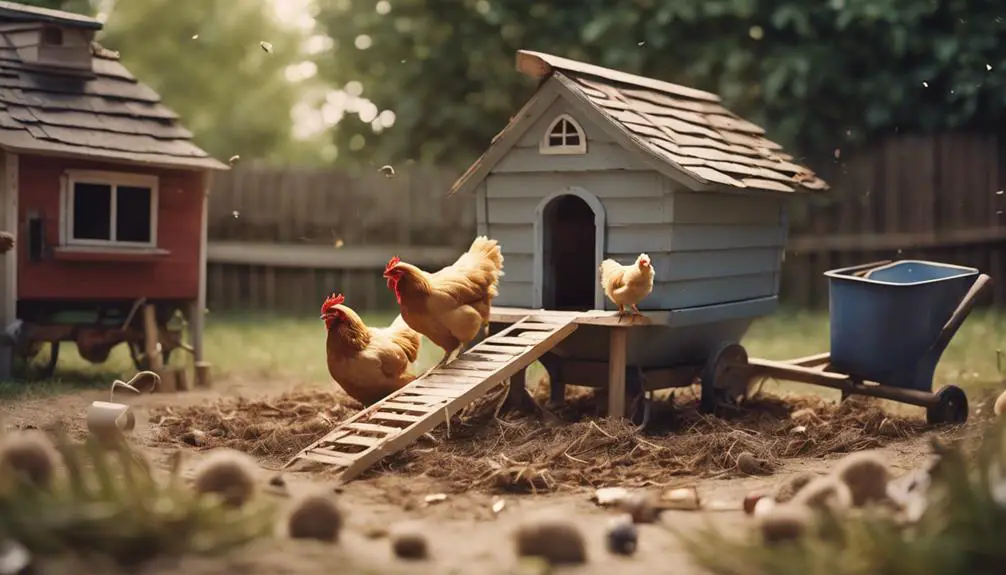
You'll need to develop a plan for managing and disposing of your backyard chickens' waste, which can quickly accumulate and create unpleasant odors and health hazards if not addressed properly.
A vital step is waste segregation, where you separate the waste into different categories, such as droppings, bedding, and uneaten feed.
This segregation enables you to compost the manure effectively, which is a valuable nutrient-rich fertilizer for your garden.
Manure composting is an excellent way to recycle your chickens' waste, reducing the environmental impact and creating a natural fertilizer.
You can compost the manure in a dedicated bin or pile, mixing it with carbon-rich materials like leaves or straw to speed up the decomposition process.
Regularly turning the compost pile and maintaining the right moisture levels will guarantee the composting process is efficient and odor-free.
Weather and Climate Considerations
Your backyard chickens' health and productivity are heavily influenced by the local weather and climate, making it essential to ponder these factors when designing and managing their living space.
As you plan, consider the temperature fluctuations your chickens will face. Chickens can tolerate a wide range of temperatures, but extreme heat or cold can be detrimental to their health. Guarantee your coop is well-ventilated to prevent overheating in the summer and provide adequate insulation to keep them warm in the winter.
Humidity tolerance is also pivotal, as high humidity can lead to respiratory issues. A dry and well-drained coop is indispensable to maintaining a healthy environment.
Additionally, consider the wind direction and speed when placing your coop to minimize drafts and moisture accumulation. By understanding the local climate and weather patterns, you can create a safe and comfortable space for your backyard chickens to thrive.
This attention to detail will help you provide the best possible care for your flock, guaranteeing they remain healthy, happy, and productive.
Budgeting and Cost Estimates

Estimating the costs of raising backyard chickens is crucial to creating a sustainable and enjoyable experience, so paramount to set a realistic budget that covers initial setup, ongoing expenses, and potential unexpected costs.
You'll need to ponder the initial investment, which includes the cost of the coop, fencing, feeders, and chickens themselves. This can range from a few hundred to several thousand dollars, depending on the size and complexity of your setup.
Ongoing expenses will include feed, healthcare, and supplies, which can add up to around $50 to $100 per month, depending on the number of chickens you're keeping.
You may also need to budget for occasional vet visits, replacement parts for your coop, and other unexpected costs. Fundamental to factor these expenses into your budget is to avoid financial strain.
Time Commitment and Responsibilities
Raising backyard chickens requires a significant time commitment, and it's vital to understand the daily and weekly responsibilities involved in caring for your flock to guarantee their health and happiness.
You'll need to allocate time each morning for chores, such as feeding, watering, and collecting eggs. Morning chores typically take around 30 minutes to an hour, depending on the size of your flock.
In the evening, you'll need to secure your chickens in their coop to protect them from predators, which adds another 30 minutes to your daily routine.
Weekly responsibilities include cleaning the coop, rejuvenating bedding, and monitoring your chickens' health. You'll also need to rotate their pasture area, if you have one, to confirm they've access to fresh grass and prevent overgrazing.
Additionally, you'll need to schedule regular veterinary check-ups and maintain accurate records of your flock's health and vaccinations.
Local Resources and Support Networks
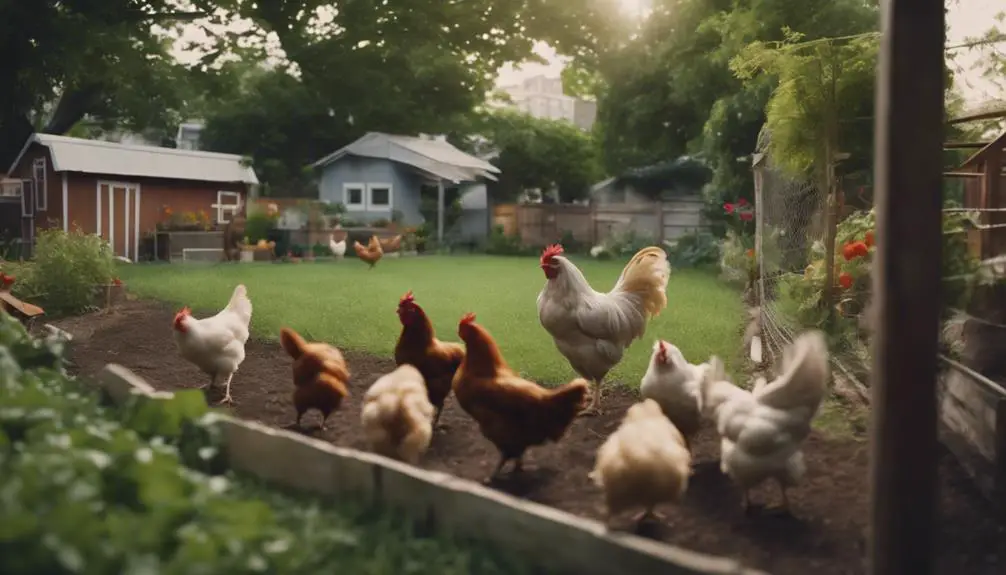
Local resources and support networks can provide valuable guidance, encouragement, and practical assistance as you navigate the journey of backyard chicken-keeping.
You'll find that connecting with local experts and like-minded individuals can make a significant difference in your success. Look for chicken clubs or poultry meetups in your area, where you can ask questions, share experiences, and learn from others who've already overcome common challenges.
These groups often host workshops, webinars, or online forums where you can access a wealth of information on topics such as coop design, predator control, and disease management.
Additionally, many local extension offices or 4-H clubs offer resources and guidance specifically tailored to backyard chicken-keepers.
They may provide access to experts, educational materials, and even hands-on training.
Don't be afraid to reach out to local farmers or breeders who may be willing to share their expertise or offer advice.
Frequently Asked Questions
Can I Have a Rooster in My Backyard Flock?
You're wondering if you can have a rooster in your backyard flock? Well, it depends – roosters can be loud and aggressive, so check if your local permits allow them, and be prepared to manage their behavior and potential conflicts.
Do Chickens Make Good Pets for Young Children?
You'll find that chickens can make great pets for young children, teaching them valuable lessons about child supervision and learning responsibility, but it's essential you're involved in their daily care and handling to guarantee a safe and enjoyable experience.
Can I Integrate Chickens With My Existing Pets?
'You're wondering if you can integrate chickens with your existing pets? Absolutely, but introduce them slowly to guarantee pet harmony. Supervise interactions between your furry friends and chickens to prevent conflicts and create a peaceful coexistence.'
Will I Need to Worry About Attracting Pests or Rodents?
You'll definitely need to ponder the potential for attracting pests or rodents, as chickens can create food sources and mouse habitats through scattered feed and manure, so be prepared to implement preventative measures to keep them at bay.
Are Backyard Chickens Noisy and Will They Disturb Neighbors?
You'll find backyard chickens can be noisy, especially during their morning chorus, but noise levels can be managed with proper coop design and placement, ensuring you won't disturb neighbors and can still enjoy your feathered friends.
Conclusion
You've done your homework, and now you're ready to bring backyard chickens into your life.
Remember, it's a commitment that requires attention to detail and dedication.
Stay vigilant about zoning laws, coop design, and predator protection.
Prioritize health and hygiene, and establish a daily care routine.
Be prepared for weather and climate challenges, and budget accordingly.
With the right mindset and resources, you'll enjoy a rewarding experience and fresh eggs for years to come.




